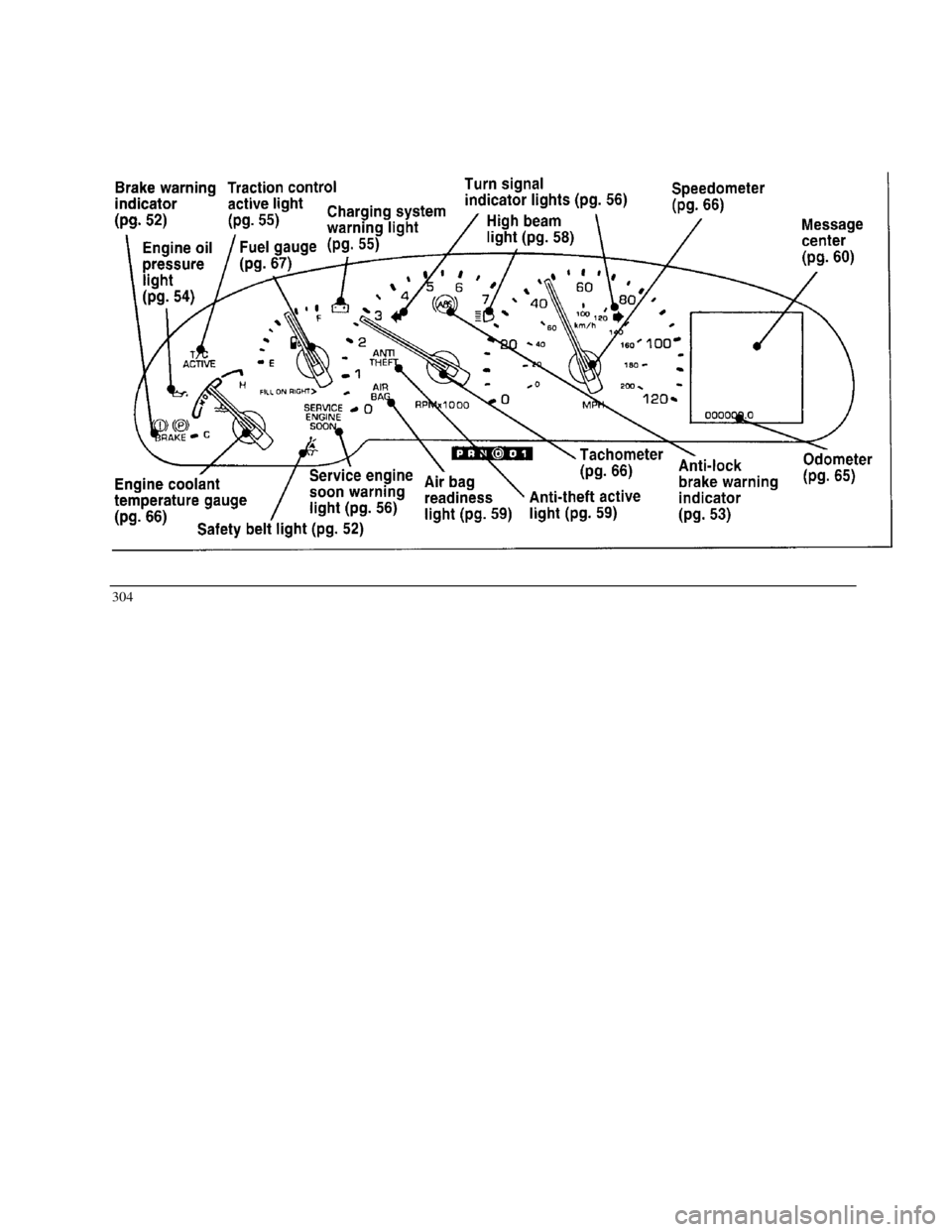1996 LINCOLN CONTINENTAL oil pressure
[x] Cancel search: oil pressurePage 57 of 320

Engine Oil Pressure Warning Light
This light indicates the engine's oil pressure, not
the oil level. However, if your engine's oil level
is low, it could affect the oil pressure. The
light will come on briefly when you turn your
key to the START and ON position. The light
should stay off when the engine is running with
normal oil pressure. If the light comes on while
the engine is running, you have lost oil pressure
and continued operation will cause severe
engine damage.
54If you lose engine oil pressure:
1. Pull off the road as soon as safely possible.
2. Shut off the engine immediately or severe engine
damage could result.
3. Check the engine's oil level, following the
instructions on checking and adding engine oil,
see the Engine Oil in the Index. If you do not
follow these instructions, you or others could be
injured. To assure an accurate reading, your car
should be on level ground.
4. If the level is low, add only as much oil as
necessary before you start the engine again. Do
not overfill. Do not operate the engine if the light
is on, regardless of the oil level. Contact your
nearest dealer for further service actions.
For more information about adding oil, see Adding
engine oil in the Servicing Your Vehicle chapter.
Page 65 of 320

Doors Closed Trunk Closed Trunk Closed Exterior Lamps Distance to Empty Fuel Level TractionControl (if equipped)
System Warnings
System warnings alert you to possible
problems or malfunctions in your vehicle's
operating systems. There are up to 18 warning
messages which can be displayed by the M/C
to show the status of the monitored systems.
The M/C will display the last selected feature if
there are no more warning messages. This
allows you to use the full functionality of the
M/C after you acknowledge the warning by
pressing the RESET button and clearing the
warning message.
62WARNINGACT10NDoor AjarDriver's Door AjarCheck Engine TempCheck Charging SystemLow Fuel LevelWarning returns after 10 minutesLow Engine CoolantLow Oil LevelLow Tire Pressure(if equipped)Headlamp OutBrake Lamp OutCheck Traction Control(if equipped)Check Ride ControlTrunk AjarWarning reappears after key is turnedCheck Steering Assistfrom OFF to ONLow Washer FluidAir Leveling DisabledTail lamp OutFront Turn Lamp Out
Page 246 of 320

Using speed control in hilly terrain Extended use of the A/C, defroster, rear window
defroster and other accessories Underinflated tires Heavy loads Aftermarket add-ons such as bike, ski or luggage
racks, bug deflectors, etc.
Self-Service Pointers
If you choose to do your own fueling, you should
also perform a few simple maintenance routines.
This extra effort will save you additional money and
contribute to the driving efficiency of your vehicle.
The following procedures require only a tire gauge,
a rag, an oil can spout and windshield washer fluid.Check the engine oil at every refueling stopClean the windshield, outside mirrors and
headlights
244 Check windshield washer fluid Check tires for excessive wear or worn edges Check the tire pressure at least monthly
Engine Oil Recommendations
We recommend using Motorcraft oil or an equivalent
oil meeting Ford Specification ESE-M2C153-E and
displaying the American Petroleum Institute
CERTIFICATION MARK on the front of the
container.
Page 262 of 320

loading, either separately or in combination, can
cause heat buildup and possible tire failure.
Snow tires
The tires on your vehicle have all-weather treads
that provide traction in rain or snow. However,
during the winter months in some climates, you may
need to use snow tires.
Use of tire chains is not recommended. The use of
tire chains could result in damage to your vehicle./!\ WARNINGSnow tires must be the same size and gradeas the tires you Currently have on yourvehicle.Cleaning the Wheels
Wash the wheels with the same detergent you use
to wash your vehicle's body. Do not use acid-based
wheel cleaners, steel wool, abrasives, fuel, or strong
260detergents. These substances will damage protective
coatings. Use tar and road oil remover to remove
grease and tar.
NOTE: Before going to a car wash, find out if the
brushes are abrasive.
If you have whitewall tires that are difficult to clean
with regular detergent, use whitewall tire cleaner.
Follow the directions on the container and rinse the
tires with plenty of clean water.
Securitires (If equipped)
Securitires are designed to allow you to continue
driving your Continental a limited number of miles
when one of your vehicle's tires is at low or even
zero air pressure./!\ WARNINGDo not use aerosol tire inflator/sealer withSecuritires. Doing so may damage the tire'spressure sensor.
Page 287 of 320

Ford strongly recommends the use of genuine Ford
replacement parts. If other than Ford or
Motorcraft parts or Ford authorized
remanufactured parts are used for maintenance
replacements or for the service of components
affecting emission control, such non-Ford parts
should be equivalent to genuine Ford Motor
Company parts in performance and durability. It is
the owner's responsibility to determine the
equivalency of such parts. Please consult your
warranty booklet for complete warranty
information./!\ WARNINGDo not park, idle, or drive your vehicle in drygrass or other dry ground cover. Theemission system heats up the enginecompartment and exhaust system, which canstart a fire.Watch for fluid leaks, strange odors, smoke, loss
of oil pressure, the charge warning light, the checkengine light, or the temperature warning light. These
sometimes indicate that the emission system is not
working properly.
Do not make any unauthorized changes to your
vehicle or engine. Changes that cause more unburned
fuel to reach the exhaust system can increase the
temperature of the engine or exhaust system.
By law, anyone who manufactures, repairs, services,
sells, leases, trades vehicles, or supervises a fleet of
vehicles is not permitted to intentionally remove an
emission control device or prevent it from working.
In some of the United States and in Canada, vehicle
owners may be liable if their emission control device
is removed or is prevented from working.
Do not drive your vehicle if it does not operate
properly. See your dealer if the engine runs on for
more than five seconds after you shut it off or if it
misfires, surges, stalls, or backfires.
285
Page 289 of 320

3.Drive to accumulate at least four (4) minutes
in the range of 30-45 mph (50-70 km/h). If
stop and go conditions occur, the
accumulative time must be within the 30-45
mph (50-70 km/h) range. No wide open
throttle conditions should be encountered.
4.Cruise and maintain a select speed in the range
of 30-40 mph (48-64 km/h) on a level road
with throttle held very steady for at least one
(1) minute.
5.Decelerate and idle for at least 80 seconds.
6.Accelerate to 55 mph (90 km/h) at ½ throttle.
7.Decelerate at closed throttle for I 0 seconds.
8. Cruise and maintain a select speed in the range
of 40-65 mph (64-105 km/h) on a level road
with throttle held very steady for at least 80
seconds.9. Complete 10 minutes of city driving 25-40 mph
(40-64 kin/h) with at least six (6) stops.
10. OBD II drive cycle has been completed.
Vehicle can be turned off when convenient.
Refill Capacities, Motorcraft Parts,
and Lubricant Specifications
Refill Capacities
ComponentU.S.MetricCooling system
(including heater)14.25 qts.13.5 litersEngine oil
(with filter change)6.0 qts.5.7 litersTransaxle
Auto. overdrive13.7 qts.13.0 litersPower steering2.5 pints1.2 litersFuel tank17.8 gallons67.4 litersPressure cap16 psiI 10 kPa287
Page 302 of 320

Brake warning indicator Engine oil pressure light Traction control active light Charging system warning light Fuel gauge ANTI
THEFT active light Service engine soon warning light Engine coolant temperature gauge Safety belt light Turn signal indicator lights High beam light
Air bag readiness light Speedometer Tachometer Anti-theft active light Anti-lock brake warning indicator Message center Odometer304
Page 310 of 320

Engine coolant temperature gauge,.Fluid refill capacities.............................287
description..............................66Ford Dispute Settlement Board............214
Engine fan......................................233Ford Extended Service Plan......................6
Engine oil.......................................Ford Motor Company of Canada..........219
"break-in" oils............................6Ford of Canada Customer...........................
changing oil and oil filter............247Assistance Centre...............................219
checking and adding..................245Foreign registration..............................221
dipstick......................................246French owner guides, how to obtain.........3
disposal232, 250, 262.Fuel............................................................
engine oil pressure warning light54calculating fuel economy..................243
filter, specifications....................288capacity...........................................287
refill capacities...........................28-choosing the right fuel......................240
specifications.............................289comparisons with EPA fuel economy.....
synthetic oil...............................245estimates.......................................243
viscosity....................................245filling your vehicle with fuel.............238
Exhaust fumes................................49filter, specifications..........................288
Extended Service Plan, Ford...........6fuel gauge..........................................67
F....................running out of fuel...........................242
Flashers, hazard..............................92safety information relating to..................
Flashing the lights...........................90automotive fuels............................241
Flat tire..........................................204storing your vehicle..........................291
......................................................treating emergencies........................241
312